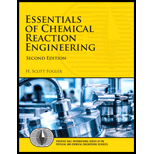
Example 5-1. (1) What would be the error in
(1)
Interpretation:
The error in the value of
Concept Introduction:
For a Continuous Stirred Tank Reactor (CSTR), the design equation to be used is:
Here,
Answer to Problem 5.4Q
The new value of
There is no error in the new value.
Explanation of Solution
Given information:
Example 5.1 data:
In a batch reactor, 500 mL of 2 M
Here
Since the reaction is first order in A, rate law is:
Concentration time data for ethylene glycol (C) is given as:
| Time (min) | Concentration of ethylene glycol |
| 0.0 | 0.000 |
| 0.5 | 0.145 |
| 1.0 | 0.270 |
| 1.5 | 0.376 |
| 2.0 | 0.467 |
| 3.0 | 0.610 |
| 4.0 | 0.715 |
| 6.0 | 0.848 |
| 10.0 | 0.957 |
Example- 5.1 when the batch reactor is filled completely.
For constant volume batch reactor, the equation that relates concentration, time and rate constant for first order reaction is:
Table prepared for processed data for
| Time (min) | Concentration of ethylene glycol
|
|
| 0.0 | 0.000 | -0.0000 |
| 0.5 | 0.145 | -0.1570 |
| 1.0 | 0.270 | -0.3150 |
| 1.5 | 0.376 | -0.4720 |
| 2.0 | 0.467 | -0.6290 |
| 3.0 | 0.610 | -0.9420 |
| 4.0 | 0.715 | -0.1.2550 |
| 6.0 | 0.848 | -1.08840 |
| 10.0 | 0.957 | -3.1470 |
The graph of
When the reactor is filled 80% with the same concentration of reactants, equation (2) remains unaffected. Thus, the value of k does not depend on the volume of the reactor and is dependent on the concentration of the reactants and products. Hence, the new value of
Therefore, there is no error in the value of specific reaction rate.
(2)
Interpretation:
The generalization from the results of part (1) is to be inferred.
Concept Introduction:
For a Continuous Stirred Tank Reactor (CSTR), the design equation to be used is:
Here,
Explanation of Solution
From the results of given example-5.1 and part (1), it can be generalized that for the first order reactions, specific reaction rate is independent of the reactor volume and is dependent on the concentration of ethylene oxide (A) and ethylene glycol (C). Any change in the volume of the reactor without altering the concentration will not affect the specific reaction rate.
Want to see more full solutions like this?
Chapter 5 Solutions
Essentials of Chemical Reaction Engineering (2nd Edition) (Prentice Hall International Series in the Physical and Chemical Engineering Sciences)
 Introduction to Chemical Engineering Thermodynami...Chemical EngineeringISBN:9781259696527Author:J.M. Smith Termodinamica en ingenieria quimica, Hendrick C Van Ness, Michael Abbott, Mark SwihartPublisher:McGraw-Hill Education
Introduction to Chemical Engineering Thermodynami...Chemical EngineeringISBN:9781259696527Author:J.M. Smith Termodinamica en ingenieria quimica, Hendrick C Van Ness, Michael Abbott, Mark SwihartPublisher:McGraw-Hill Education Elementary Principles of Chemical Processes, Bind...Chemical EngineeringISBN:9781118431221Author:Richard M. Felder, Ronald W. Rousseau, Lisa G. BullardPublisher:WILEY
Elementary Principles of Chemical Processes, Bind...Chemical EngineeringISBN:9781118431221Author:Richard M. Felder, Ronald W. Rousseau, Lisa G. BullardPublisher:WILEY Elements of Chemical Reaction Engineering (5th Ed...Chemical EngineeringISBN:9780133887518Author:H. Scott FoglerPublisher:Prentice Hall
Elements of Chemical Reaction Engineering (5th Ed...Chemical EngineeringISBN:9780133887518Author:H. Scott FoglerPublisher:Prentice Hall
 Industrial Plastics: Theory and ApplicationsChemical EngineeringISBN:9781285061238Author:Lokensgard, ErikPublisher:Delmar Cengage Learning
Industrial Plastics: Theory and ApplicationsChemical EngineeringISBN:9781285061238Author:Lokensgard, ErikPublisher:Delmar Cengage Learning Unit Operations of Chemical EngineeringChemical EngineeringISBN:9780072848236Author:Warren McCabe, Julian C. Smith, Peter HarriottPublisher:McGraw-Hill Companies, The
Unit Operations of Chemical EngineeringChemical EngineeringISBN:9780072848236Author:Warren McCabe, Julian C. Smith, Peter HarriottPublisher:McGraw-Hill Companies, The





